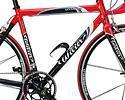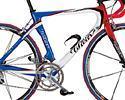
|
Eurobike EICMA Cycle 2002 Interbike Australia Tokyo 2002 Chris Davidson Diary |
|
Tokyo pics Australia pics Interbike pics Cycle 2002 pics EICMA pics Eurobike pics |
Recently on Cyclingnews.com |
Interbike 2002
Las Vegas, USA, October 5 - 8, 2002
Interbike part 20 - Gerolsteiner and Lampre to ride Wilier Triestina in 2003
By Gerard Knapp in Las Vegas
 |
One of Italy's longest-standing bicycle manufacturers, Wilier Triestina, will have a major presence in the pro peloton in 2003, with both the Gerolsteiner and Lampre teams riding the company's bikes for the next two years.
This year at Interbike, the company's US distributor Velo Imports was showing the range to the growing US high-end road bike market, offering the same full carbon and aluminium/carbon models that are used in Europe.
This year the company sponsored Mercatone Uno and while there was some guaranteed publicity from the team of Marco Pantani, fair to say it wasn't the kind it was used to, as its machines have been ridden to victory many times, dating back to Fiorenzo Magni in the 1948 Giro d'Italia.
Next year the company is also certain to see race victories, given the consistent performances by the Lampre and Gerolsteiner squads this year, from the Spring Classics through to the Grand Tours.
 |
In more recent years, Mercatone Uno rode Wilier in 1997 when Pantani won the Alpe D'Huez and Morzine stages at the Tour De France and placed third overall. Sergei Gonchar won the 2000 World Time Trial Championship on Wilier, while Davide Rebellin also rode on Wilier in 2001 while he was with Team Liquigas-Pata. Indeed, many observers believed Rebellin was still riding a Wilier in 2002 despite the change of bike sponsorship, although this would not be confirmed by the company.
In 2002, the Wilier Triestina models used by Mercatone Uno included the Izoard, while Pantani chose the composite-frame Karbon 2.
Next year, Gerolsteiner and Lampre will ride the 2003 Izoard model, a scandium compact geometry frame with a thin layer of carbon fibre wrapped around the top, down and seat tubes. Added to the carbon rear triangle and carbon forks, the carbonwrapping is said to further absorb road shock.
The stars of the two squads will also have the Galibier at their disposal, which is also in the compact style, but this is of carbon monocoque construction with an oversized downtube.
 |
Pantani's choice, the Karbon 2, will also be ridden by Gerolsteiner rider Davide Rebellin next year. This is also a carbon monocoque frame, but the sloping geometry is different in that the seat tube is offset forward of the bottom bracket, allowing for shorter seat stays, typically 10mm less than normal. In turn, the seat tube angle is more relaxed (70 degrees) to accommodate the forward-positioned seat tube, and the end result is that the two wheels come closer together and shorten the wheelbase.
The forward-positioned seat tube makes the Karbon 2 somewhat radical compared to most road machines, yet viewed from the right (ie, drive) side, it looks almost like a conventional frame.
It also shows the company is not locked into the history of the bicycle, as it claims to be one of the first to use scandium, sloping geometry and carbon monostays. At the same time, Wilier Triestina is one of the oldest Italian cycling brands. It has had an interesting corporate history, after it was founded in 1906 by Pietro Dal Molin of Bassano del Grappa. Under his leadership and then that of one of his sons, Mario, the company continued through two world wars. It was renamed Wilier Triestina in 1945 and was known for its reddish, copper-coloured machines, which became something of an identifier for the brand.
The company sponsored professional cycling teams and hit a peak in 1948 with Magni's win in the Giro, while the company grew to where it produced 200 bikes per day. More race victories followed in the Tour of Flanders and Tour de France. But by 1952, the firm and its ambitious production output became a victim of increasing motorisation of the Italian people via scooters and motorcycles.
In 1969, the Gastaldello brothers from Rossano Veneto, bought the Wilier Triestina trademark and once again started producing the copper-coloured bicycles. It now produces a wide range of bicycles for road, dirt and generic pavement models.
For more info:
Wilier Triestina - www.wilier.it
(Flash-based site but quite fun; also in English)
Velo Imports (US distributor) - www.veloimports.com
Photos
Images by Wilier
- Next year, the stars of Gerolsteiner and Lampre will ride the Galibier carbon monocoque model.
- The Izoard is something of a hybrid - the main triangle is made from scandium with carbon fibre wrapped around the main tubes.
- The forward-position seat tube is a distinguising feature of this carbon monocoque frame
- Mercatone Uno looked the part in 2002, and couldn't complain about their bikes.
